1.Plantar fascia stretches
Regular stretching of the plantar fascia has been shown to be effective in the treatment of plantar fasciitis.
As shown in the pictures, there are two options:
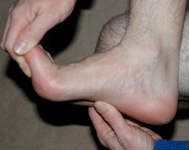
i. Cross over stretch
If you have a painful right heel: When sitting, cross your right leg over your left thigh and hold your toes with your right hand, then bend your toes upwards. In this position with your left hand feel along the sole of your foot, if you are adequately stretching the plantar fascia you will feel a tight band along your foot.
OR
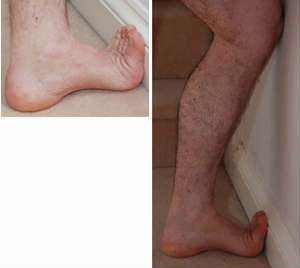 ii. Wall stretch
ii. Wall stretch
If you have a painful right heel place the toes on your right foot against the wall with your toes bent upwards, then bend your leg forward at the ankle, i.e. moving your knee towards the wall.
Each stretch should be held for 10 seconds and performed 10 times, this group of stretches should be performed 3 times per day.
2. Calf stretches
It has been shown that there is often a link between tightness of the calf muscles and plantar fasciitis and that stretching these muscles can reduce the pain of plantar fasciitis. The exercises that should be performed are shown in the photos.
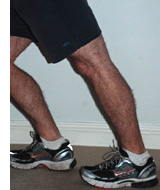 i. Standing Stretch
i. Standing Stretch
The muscles that are most often tight are the gastrocnemius muscles, these can be stretched by standing with your feet pointing forwards (wearing shoes with orthotics in them if you usually wear them), resting your hands against a wall, if you have a painful right heel then this leg should be positioned slightly behind the left and the ankle is bent forward, it is important to KEEP YOUR KNEE STRAIGHT.
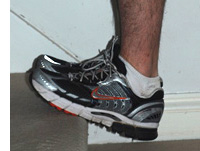 ii. Eccentric stair stretch
ii. Eccentric stair stretch
This is another stretch for the gastrocnemius muscles: standing on a stair balancing yourself using the banister or the wall position your toes on the edge of the step, rise up on both feet and then drop your heels down (this bends the foot up) again KEEP YOUR KNEE STRAIGHT (if possible lower down balancing on the affected leg only, however it is often easier to drop both heels down together). This should be performed in sets of 3, performing 15 ’lowerings’ in each set and repeating this twice a day
 ii. Sitting Stretch
ii. Sitting Stretch
This is a further stretch for the gastrocnemius: whilst sitting with your legs straight out in front of you, loop a theraband or a towel or dressing gown cord underneath your foot, then gradually use it to pull your foot towards you KEEPING YOUR KNEE STRAIGHT.
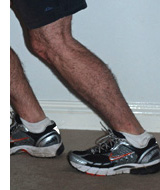 iii. Soleus stretches
iii. Soleus stretches
This muscle can be stretched using the standing stretch above, but allowing your knee to bend as you bend the ankle forward, as you bend the knee you will usually feel that you are able to move the knee closer to the wall. This stretch is less important.
Other than the stair stretch (see above) these stretches should be held for 30 seconds and repeated 3 times, they should be performed 3 times per day.
